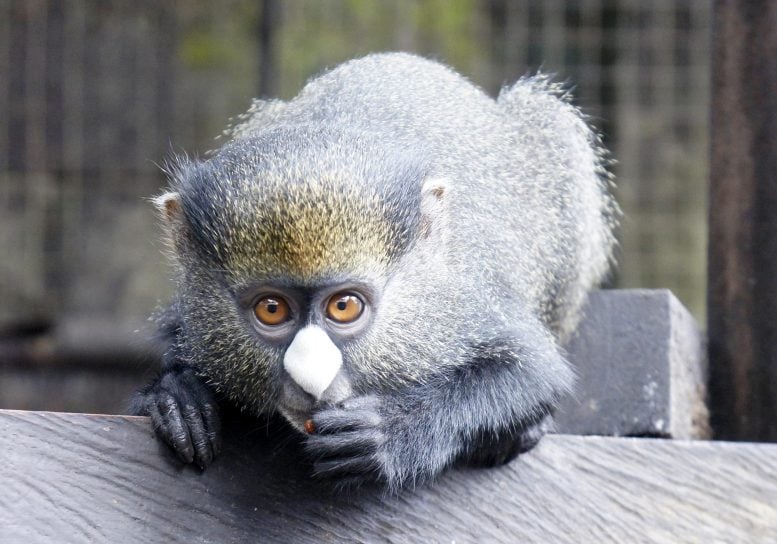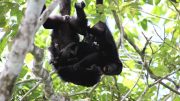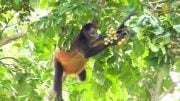
A new study by an MIT linguist shows that the speech calls of some monkeys may be more sophisticated than realized, but are still far removed from the complexity of human language.
Picture is a young Putty-nosed monkey (Cercopithecus nictitans), rescued by CERCOPAN primate sanctuary in Nigeria. Credit: LaetitiaC/Wikipedia
Study shows Old World monkeys combine items in speech — but only two and never more, unlike humans.
The utterances of Old World monkeys, some of our primate cousins, maybe more sophisticated than previously realized — but even so, they display constraints that reinforce the singularity of human language, according to a new study co-authored by an MIT linguist.
The study reinterprets evidence about primate language and concludes that Old World monkeys can combine two items in a language sequence. And yet, their ability to combine items together seems to stop at two. The monkeys are not able to recombine language items in the same open-ended manner as humans, whose languages generate an infinite variety of sequences.
“We are saying the two systems are fundamentally different,” says Shigeru Miyagawa, an MIT linguist and co-author of a new paper detailing the study’s findings.
That might seem apparent. But the study’s precise claim — that even if other primates can combine terms, they cannot do so in the way humans do — emphasizes the profound gulf in cognitive ability between humans and some of our closest relatives.
“If what we’re saying in this paper is right, there’s a big break between two [items in a sentence], and [the potential for] infinity,” Miyagawa adds. “There is no three, there is no four, there is no five. Two and infinity. And that is the break between a nonhuman primate and human primates.”
The paper, “Systems underlying human and Old World monkey communications: One, two, or infinite,” is published today in the journal Frontiers in Psychology. The authors are Miyagawa, who is a professor of linguistics at MIT; and Esther Clarke, an expert in primate vocalization who is a member of the Behavior, Ecology, and Evolution Research (BEER) Center at Durham University in the U.K.
To conduct the study, Miyagawa and Clarke re-evaluated recordings of Old World monkeys, a family of primates with over 100 species, including baboons, macaques, and the proboscis monkey.
The language of some of these species has been studied fairly extensively. Research starting in the 1960s, for example, established that vervet monkeys have specific calls when they see leopards, eagles, and snakes, all of which require different kinds of evasive action. Similarly, tamarin monkeys have one alarm call to warn of aerial predators and one to warn of ground-based predators.
In other cases, though, Old World monkeys seem capable of combining calls to create new messages. The putty-nosed monkey of West Africa, for example, has a general alarm call, which scientists call “pyow,” and a specific alarm call warning of eagles, which is “hack.” Sometimes these monkeys combine them in “pyow-hack” sequences of varying length, a third message that is used to spur group movement.
However, even these latter “pyow-hack” sequences start with “pyow” and end with “hack”; the terms are never alternated. Although these sequences vary in length and consequently can sound a bit different from each other, Miyagawa and Clarke break with some other analysts and think there is no “combinatorial operation” at work with putty-nosed monkey language, unlike the process through which humans rearrange terms. It is only the length of the “pyow-hack” sequence that indicates how far the monkeys will relocate.
“The putty-nose monkey’s expression is complex, but the important thing is the overall length, which predicts behavior and predicts how far they travel,” Miyagawa says. “They start with ‘pyow’ and end up with ‘hack.’ They never go back to ‘pyow.’ Never.”
As a result, Miyagawa adds, “Yes, those calls are made up of two items. Looking at the data very carefully it is apparent. The other thing that is apparent is that they cannot combine more than two things. We decided there is a whole different system here,” compared to human language.
Similarly, Campbell’s monkey, also of West Africa, deploys calls that might be interpreted as evidence of human-style combination of language items, but which Miyagawa and Clarke believe are actually a simpler system. The monkeys make sounds rendered as “hok,” for an eagle alarm, and “krak,” for a leopard alarm. To each, they add an “-oo” suffix to turn those utterances into generalized aerial alarms and land alarms.
However, that does not mean the Campbell’s monkey has developed a suffix as a kind of linguistic building block that could be part of a more open-ended, larger system of speech, the researchers conclude. Instead, its use is restricted to a small set of fixed utterances, none of which have more than two basic items in them.
“It’s not the human system,” Miyagawa says. In the paper, Miyagawa and Clarke contend that the monkeys’ ability to combine these terms means they are merely deploying a “dual-compartment frame” which lacks the capacity for greater complexity.
Miyagawa also notes that when the Old World monkeys speak, they seem to use a part of the brain known as the frontal operculum. Human language is heavily associated with Broca’s area, a part of the brain that seems to support more complex operations.
If the interpretation of Old World monkey language that Miyagawa and Clarke put forward here holds up, then humans’ ability to harness Broca’s area for language may specifically have enabled them to recombine language elements as other primates cannot — by enabling us to link more than two items together in speech.
“It seems like a huge leap,” Miyagawa says. “But it may have been a tiny [physiological] change that turned into this huge leap.”
As Miyagawa acknowledges, the new findings are interpretative, and the evolutionary history of human language acquisition is necessarily uncertain in many regards. His own operating conception of how humans combine language elements follows strongly from Noam Chomsky’s idea that we use a system called “Merge,” which contains principles that not all linguists accept.
Still, Miyagawa suggests, further analysis of the differences between human language and the language of other primates can help us better grasp how our unique language skills evolved, perhaps 100,000 years ago.
“There’s been all this effort to teach monkeys human language that didn’t succeed,” Miyagawa notes. “But that doesn’t mean we can’t learn from them.”









Be the first to comment on "Old World Monkeys Vocalizations May Be More Sophisticated Than Previously Realized"